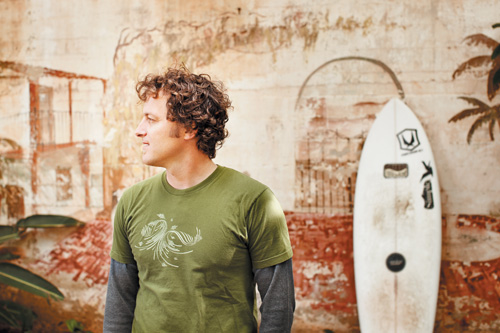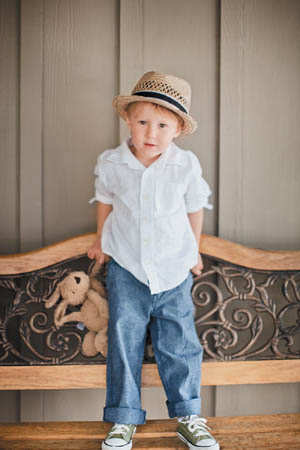5. The Plot Thickens

OPPOSITE At first glance, what looks like a couple of guys out for an afternoon trip is actually an epic ocean travel saga. In this small hand-built boat, they traveled for hundreds of nautical miles exploring the wilderness of the sea.
Canon 5DMii, 50mm lens, f/8
I HAVE A FANTASTIC UNCLE named Jim. When I was a young child, he convinced my brother and me that an alligator lived in the closet underneath the stairs in his house. He and his sons (my cousins Steve and Jon) would always have an adventure, trick, or story up their sleeve. They taught us how to build elaborate Lego sets, light firecrackers, do flips into the pool, and literally eat the icing off of the cake. When it came to boyhood fun, they were true sages who showed us how to live.
We hung on each of their words as if they were sacred text. And they were storytellers of Biblical scale. They could weave together stories that would make us laugh without control and shiver in fear. But after returning home to our friends, if we tried to retell one of their tales it just didn’t work. Even if we memorized every detail of the scene, without Uncle Jim telling the stories, the inspiration was lost.
It was from these early childhood experiences that I was first exposed to the idea of storytelling as an art form that requires a special touch. It begins with understanding that good stories are built with common elements. Each story must have a cohesive, convincing, and captivating plot. The structure or the framework is the plot and it’s relatively easy to describe. The characters are revealed and the events take place and the plot matters. Yet, as every talented storyteller knows, it’s not the plot by itself that makes a story ring true.
In metaphorical terms, if storytellers were chefs, the plot would be the basic ingredients used to bake bread. What makes a plot come alive is the magic a chef (or my Uncle Jim) would provide. This magic is based on the plot’s narrative appeal.
If the plot is the overarching story, the narrative is the part that consists of the small details and the way the message is told. It’s the aesthetics that make a story stick or the yeast that makes the bread rise. If the plot thickens, without good narrative, even the most interesting story won’t have an appetizing appeal.
Adding the Small Details to Build Narrative
Narrative is that extra little detail that means so much. And narrative shows up in all the arts, from figure painting to photography and feature films. In fact, it’s because of narrative’s powerful appeal that filmmakers can successfully remake movies over time. Although they use the same structural plot, it’s the new narrative twist that makes dozens of movies like King Kong, Frankenstein, The Italian Job, and Willy Wonka and the Chocolate Factory work so well.
In photography, narrative is the extra ingredient that makes a picture take root in our heart. A photograph without narrative may have the perfect plot, but it will just seem bland. In contrast, the people pictures with narrative depth are like a savory visual feast. The nuances, details, and aesthetics wake up our imaginations and entice our senses like the aroma of fresh-baked bread.

This crumbling hand-painted wall illuminated with soft dappled light and the sideways glance of the subject creates an interesting narrative tone.
Canon 5DMii, 50mm lens, f/4
Exercise: Narrative Portraiture
Approaching portraiture from a narrative point of view can be an exciting and rewarding endeavor. Soon you will realize that with just a small shift in perspective, your pictures can connect with a larger audience and have a more lasting impact. Here’s the best part: Narrative portraiture doesn’t require a specialized set of skills, traveling to exotic locations, elaborate set design, or highly conceptual ideas. Rather, making narrative portraits is simple and something anyone can do.
Step 1 Choosing a Subject
Select a subject who has an interesting personality, is dramatic, or has a vibrant point of view. Consider contacting a local acting club or theater and inquire if there is an actor interested in taking part in a portrait project. If you are going to be working with a professional, be sure to offer something in exchange for the subject’s time. Or find a friend who has a colorful and engaging personality. Either way, once you have found your subject, set up a time and place for the shoot.
Tips
If the photo shoot isn’t going as planned, don’t force it but instead try something new. Always keep in mind that the most powerful stories aren’t forced and have a natural flow.
If you are stuck trying to come up with narrative ideas, draw inspiration from the theater, movies, books, and music that you like most.
One of the best sources of narrative inspiration is to look to the past. History is a wealth of archetypical and abstract tales.
Step 2 Location and Design
Choose a location that catches your eye. Look for small details that set the stage for the story you want to tell. Consider approaching the location like a set designer or stylist would do—are there any specific props, artifacts, or wardrobe elements that will make the plot become more rich?
Step 3 The Shoot
On the day of the shoot, think of yourself as the director and the location as a stage. Welcome the subject and express excitement about a chance to collaborate. Begin by explaining your idea for the visual story that you want to tell. Ask the subject if she has any ideas of her own. Begin shooting and capture images in a free-flowing way. Your goal is to capture one single image that best reveals a narrative idea. In order to achieve this, provide directorial feedback and praise to your subject, yet don’t overdramatize the “script.” After shooting for 30 to 45 minutes, call it a wrap.
Exercise Details
Goal: Single narrative portrait. Tools: Camera; normal or telephoto focal-length lens. Light: Natural or available light. Location: An environment that acts like a stage. Theme: Narrative portraiture. Duration: 30 to 45 minutes.
Step 4 Printing One Single Frame
When it comes to storytelling, it’s easy to become long-winded and just say too much. With photography this often happens by showing too many shots. The goal for this shoot is one singular frame. Select the picture that you connect with the most and that tells the story best. Make a print of it and tack it up on your wall. Ask others for feedback and consider their advice.

LEFT Sometimes creating narrative is about responding to what you see. When Stuart climbed on this wooden bench, his hat, simple clothes and stuffed animal were all classic details that caught my eye.
Canon 5DMii, 50mm lens, f/1.2
OPPOSITE In most photographs, it’s the combination of elements that make it work. Jeff Johnson stands in front of an old paint drop cloth (see Exercise 13). His straw hat and denim shirt and the vintage tone create a mood and establish a narrative thread, inviting the viewer to linger, reflect, and gaze.
Canon 5DMii, 85mm lens, f/2
“I’ve always tried to create an environment that seems part of a bigger story, and then capture a small part of it.”
—Sam Jones

